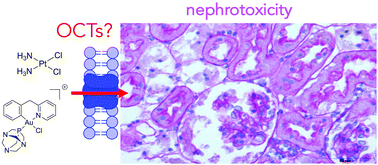当前位置:
X-MOL 学术
›
Metallomics
›
论文详情
Our official English website, www.x-mol.net, welcomes your
feedback! (Note: you will need to create a separate account there.)
On the toxicity and transport mechanisms of cisplatin in kidney tissues in comparison to a gold-based cytotoxic agent
Metallomics ( IF 2.9 ) Pub Date : 2017-10-27 00:00:00 , DOI: 10.1039/c7mt00271h Sarah Spreckelmeyer 1, 2, 3, 4, 5 , Natalia Estrada-Ortiz 1, 2, 3, 4, 5 , Gerian G. H. Prins 1, 2, 3, 4, 5 , Margot van der Zee 1, 2, 3, 4, 5 , Bente Gammelgaard 6, 7, 8, 9 , Stefan Stürup 6, 7, 8, 9 , Inge A. M. de Graaf 1, 2, 3, 4, 5 , Geny M. M. Groothuis 1, 2, 3, 4, 5 , Angela Casini 1, 2, 3, 4, 5
Metallomics ( IF 2.9 ) Pub Date : 2017-10-27 00:00:00 , DOI: 10.1039/c7mt00271h Sarah Spreckelmeyer 1, 2, 3, 4, 5 , Natalia Estrada-Ortiz 1, 2, 3, 4, 5 , Gerian G. H. Prins 1, 2, 3, 4, 5 , Margot van der Zee 1, 2, 3, 4, 5 , Bente Gammelgaard 6, 7, 8, 9 , Stefan Stürup 6, 7, 8, 9 , Inge A. M. de Graaf 1, 2, 3, 4, 5 , Geny M. M. Groothuis 1, 2, 3, 4, 5 , Angela Casini 1, 2, 3, 4, 5
Affiliation

|
Mechanisms of toxicity and cellular transport of anticancer metallodrugs, including platinum-based agents, have not yet been fully elucidated. Here, we studied the toxic effects and accumulation mechanisms of cisplatin in healthy rat kidneys ex vivo, using the Precision Cut Tissue Slices (PCTS) method. In addition, for the first time, we investigated the nephrotoxic effects of an experimental anticancer cyclometallated complex [Au(pyb-H)(PTA)Cl]PF6 (PTA = 1,3,5-triazaphosphaadamantane). The viability of the kidney slices after metallodrug treatment was evaluated by ATP content determination and histomorphology analysis. A concentration dependent decrease in viability of PCKS was observed after exposure to cisplatin or the Au(III) complex, which correlated with the increase in slice content of Pt and Au, respectively. Metal accumulation in kidney slices was analysed by ICP-MS. The involvement of OCTs and MATE transporters in the accumulation of both metal compounds in kidneys was evaluated co-incubating the tissues with cimitedine, inhibitor of OCT and MATE. Studies of mRNA expression of the markers KIM-1, villin, p53 and Bax showed that cisplatin damages proximal tubules, whereas the Au(III) complex preferentially affects the distal tubules. However, no effect of cimetidine on the toxicity or accumulation of cisplatin and the Au(III) complex was observed. The effect of temperature on metallodrug accumulation in kidneys suggests the involvement of a carrier-mediated uptake process, other than OCT2, for cisplatin; while carrier-mediated excretion was suggested in the cases of the Au(III) complex.
中文翻译:

与金基细胞毒剂相比,顺铂在肾脏组织中的毒性和转运机制
尚未充分阐明抗癌金属药物(包括铂类药物)的毒性和细胞转运机制。在这里,我们研究了顺铂的健康大鼠肾脏的毒性作用和积累机制体外,采用精密切割组织切片(PCTS)方法。此外,我们首次研究了实验性抗癌环金属化复合物[Au(py b -H)(PTA)Cl] PF 6(PTA = 1,3,5-三氮杂膦酸金刚烷)的肾毒性作用。通过ATP含量测定和组织形态学分析评估了金属药物治疗后肾切片的生存能力。暴露于顺铂或Au(III)后,观察到PCKS活力的浓度依赖性降低)复合物,分别与Pt和Au的切片含量增加相关。通过ICP-MS分析肾脏切片中的金属积累。通过将组织与OCT和MATE的抑制剂西咪替丁共同孵育,评估了OCT和MATE转运蛋白在肾脏中两种金属化合物的积累中的参与。对标记物KIM-1,villin,p53和Bax的mRNA表达的研究表明,顺铂损害近端小管,而Au(III)复合物优先影响远端小管。但是,西咪替丁对顺铂和Au(III)的毒性或积累没有影响)观察到复杂。温度对肾脏中金属药物积累的影响表明,除了OCT2以外,顺铂还涉及了一种载体介导的摄取过程。而在Au(III)络合物的情况下,建议由载体介导的排泄物。
更新日期:2017-10-27
中文翻译:

与金基细胞毒剂相比,顺铂在肾脏组织中的毒性和转运机制
尚未充分阐明抗癌金属药物(包括铂类药物)的毒性和细胞转运机制。在这里,我们研究了顺铂的健康大鼠肾脏的毒性作用和积累机制体外,采用精密切割组织切片(PCTS)方法。此外,我们首次研究了实验性抗癌环金属化复合物[Au(py b -H)(PTA)Cl] PF 6(PTA = 1,3,5-三氮杂膦酸金刚烷)的肾毒性作用。通过ATP含量测定和组织形态学分析评估了金属药物治疗后肾切片的生存能力。暴露于顺铂或Au(III)后,观察到PCKS活力的浓度依赖性降低)复合物,分别与Pt和Au的切片含量增加相关。通过ICP-MS分析肾脏切片中的金属积累。通过将组织与OCT和MATE的抑制剂西咪替丁共同孵育,评估了OCT和MATE转运蛋白在肾脏中两种金属化合物的积累中的参与。对标记物KIM-1,villin,p53和Bax的mRNA表达的研究表明,顺铂损害近端小管,而Au(III)复合物优先影响远端小管。但是,西咪替丁对顺铂和Au(III)的毒性或积累没有影响)观察到复杂。温度对肾脏中金属药物积累的影响表明,除了OCT2以外,顺铂还涉及了一种载体介导的摄取过程。而在Au(III)络合物的情况下,建议由载体介导的排泄物。











































 京公网安备 11010802027423号
京公网安备 11010802027423号